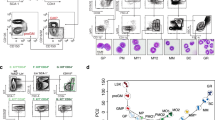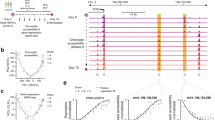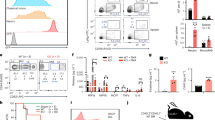Abstract
Megakaryocytes are highly specialized cells that arise from a bipotent megakaryocytic-erythroid progenitor (MEP). This developmental leap requires coordinated activation of megakaryocyte-specific genes, radical changes in cell cycle properties, and active prevention of erythroid differentiation. These programs result from upregulation of megakaryocyte-selective transcription factors, downregulation of erythroid-selective transcription factors and ongoing mediation of common erythro-megakaryocytic transcription factors. Unlike most developmental programs, no single lineage-unique family of master regulators exerts executive control over the megakaryocytic plan. Rather, an assemblage of non-unique factors and signals converge to determine lineage and differentiation. In human megakaryopoiesis, hereditary disorders of platelet production have confirmed contributions from three distinct transcription factor families. Murine models have extended this repertoire to include multiple additional factors. At a mechanistic level, the means by which these non-unique factors collaborate in the establishment of a perfectly unique cell type remains a central question.
This is a preview of subscription content, access via your institution
Access options
Subscribe to this journal
Receive 50 print issues and online access
$259.00 per year
only $5.18 per issue
Buy this article
- Purchase on Springer Link
- Instant access to full article PDF
Prices may be subject to local taxes which are calculated during checkout


Similar content being viewed by others
References
Adolfsson J, Mansson R, Buza-Vidas N, Hultquist A, Liuba K, Jensen CT et al. (2005). Identification of FLt3+ lympho-myeloid stem cells lacking erythro-megakaryocytic potential: a revised road map for adult blood lineage commitment. Cell 121: 295–306.
Akashi K, Traver D, Miyamoto T, Weissman IL . (2000). A clonogenic common myeloid progenitor that gives rise to all myeloid lineages. Nature 404: 193–197.
Bastian LS, Kwiatkowski BA, Breininger J, Danner S, Roth G . (1999). Regulation of the megakaryocytic glycoprotein IX promoter by the oncogenic ets transcription factor Fli-1. Blood 93: 2637–2644.
Breton-Gorius J, Favier R, Guichard J, Cherif D, Berger R, Debili N et al. (1995). A new congenital dysmegakaryopoietic thrombocytopenia (Paris–Trousseau) associated with giant platelet α-granules and chromosome 11 deletion at 11q23. Blood 85: 1805–1814.
Buijs A, Poddighe P, van Wijk R, van Solinge W, Borst E, Verdonck L et al. (2001). A novel CBFA2 single-nucleotide mutation in familial platelet disorder with propensity to develop myeloid malignancies. Blood 98: 2856–2858.
Cantor AB, Orkin SH . (2002). Transcriptional regulation of erythropoiesis: an affair involving multiple partners. Oncogene 21: 3368–3376.
Carpinelli MR, Hilton DJ, Metcalf D, Antonchuk JL, Hyland CD, Mifsud SL et al. (2004). Suppressor screen in Mpl−/− mice: c-Myb mutation causes supraphysiologic production of platelets in the absence of thrombopoietin signaling. Proc Natl Acad Sci USA 101: 6553–6558.
Debili N, Coulombel L, Croisille L, Katz A, Guichard J, Breton-Gorius J et al. (1996). Characterization of a bipotent erythro-megakaryocytic progenitor in human bone marrow. Blood 88: 1284–1296.
Deveaux S, Filipe A, Lemarchandel V, Ghysdael J, Romeo P-H, Mignotte V . (1996). Analysis of the thrombopoietin receptor (mpl) promoter implicates GATA and Ets proteins in the coregulation of megakaryocyte-specific genes. Blood 87: 4678–4685.
Dowton SB, Beardsley D, Jamison D, Blattner S, Li FP . (1985). Studies of a familial platelet disorder. Blood 65: 557–563.
Elagib KE, Racke FK, Mogass M, Khetawat R, Delehanty LL, Goldfarb AN . (2003). RUNX-1 and GATA-1 coexpression and cooperation in megakaryocytic differentiation. Blood 101: 4333–4341.
Emambokus N, Vegiopoulos A, Harman B, Jenkinson E, Anderson G, Frampton J . (2003). Progression through key stages of haemopoiesis is dependent on distinct threshold levels of c-Myb. EMBO J 22: 4478–4488.
Fossett N, Hyman K, Gajewski K, Orkin SH, Schulz RA . (2003). Combinatorial interactions of Serpent, Lozenge, and U-shaped regulate crystal cell lineage commitment during Drosophila hematopoiesis. Proc Natl Acad Sci USA 100: 11451–11456.
Freson K, Devriendt K, Matthijs G, Van Hoof A, De Vos R, Thys C et al. (2001). Platelet characteristics in patients with X-linked macrothrombocytopenia because of a novel GATA1 mutation. Blood 98: 85–92.
Freson K, Matthijs G, Thys C, Marien P, Hoylaerts MF, Vermylen J et al. (2002). Different substitutions at residue D218 of the X-linked transcription factor GATA-1 lead to altered clinical severity of macrothrombocytopenia and anemia and are associated with variable skewed X inactivation. Hum Mol Genet 11: 147–152.
Growney JD, Shigematsu H, Li Z, Lee BH, Adelsperger J, Rowan R et al. (2005). Loss of Runx1 perturbs adult hematopoiesis and is associated with a myeloproliferative phenotype. Blood 106: 494–504.
Hart A, Melet F, Grossfeld P, Chien K, Jones C, Tunnacliffe A et al. (2000). Fli-1 is required for murine vascular and megakaryocytic development and is hemizygously deleted in patients with thrombocytopenia. Immunity 13: 167–177.
Heller PG, Glembotsky AC, Gandhi MJ, Cummings CL, Pirola CJ, Marta RF et al. (2005). Low Mpl receptor expression in a pedigree with familial platelet disorder with predisposition to acute myelogenous leukemia and a novel AML1 mutation. Blood 105: 4664–4670.
Ho CY, Otterud B, Legare RD, Varvil T, Saxena R, DeHart DB et al. (1996). Linkage of a familial platelet disorder with a propensity to develop myeloid malignancies to human chromosome 21q22.1-22.2. Blood 87: 5218–5224.
Hock H, Meade E, Medeiros S, Schindler JW, Valk PJM, Fujiwara Y et al. (2004). Tel/Etv6 is an essential and selective regulator of adult hematopoietic stem cell survival. Genes Dev 18: 2336–2341.
Hollanda LM, Lima CSP, Cunha AF, Albuquerque DM, Vassallo J, Ozelo MC et al. (2006). An inherited mutation leading to production of only the short isoform of GATA-1 is associated with impaired erythropoiesis. Nat Genet 38: 807–812.
Ichikawa M, Asai T, Saito T, Yamamoto G, Seo S, Yamazaki I et al. (2004). AML1 is required for megakaryocytic maturation and lymphocytic differentiation, but not for maintenance of hematopoietic stem cells in adult hematopoiesis. Nature Med 10: 299–304.
Kasper LH, Boussouar F, Ney PA, Jackson CW, Rehg J, van Deursen JM et al. (2002). A transcription-factor-binding surface of coactivator p300 is required for haematopoiesis. Nature 419: 738–743.
Kuhl C, Atzberger A, Iborra F, Nieswandt B, Porcher C, Vyas P . (2005). GATA1-mediated megakaryocyte differentiation and growth control can be uncoupled and mapped to different domains in GATA1. Mol Cell Biol 25: 8592–8606.
Kundu M, Chen A, Anderson S, Kirby M, Xu L, Castilla LH et al. (2002). Role of Cbfb in hematopoiesis and perturbations resulting from expression of the leukemogenic fusion gene Cbfb-MYH11. Blood 100: 2449–2456.
Kuo Y-H, Landrette SF, Heilman SA, Perrat PN, Garrett L, Liu PP et al. (2006). Cbf beta-SMMHC induces distinct abnormal myeloid progenitors able to develop acute myeloid leukemia. Cancer Cell 9: 57–68.
Levanon D, Brenner O, Negreanu V, Bettoun D, Woolf E, Eilam R et al. (2001). Spatial and temporal expression pattern of Runx3 (Aml2) and Runx1 (Aml1) indicates non-redundant functions during mouse embryogenesis. Mech Dev 109: 413–417.
Liew CK, Simpson RJY, Kwan AHY, Crofts LA, Loughlin FE, Matthews JM et al. (2005). Zinc fingers as protein recognition motifs: structural basis for the GATA-1/Friend of GATA interaction. Proc Natl Acad Sci USA 102: 583–588.
Liu Y, Cheney MD, Gaudet JJ, Chruszcz M, Lukasik SM, Sugiyama D et al. (2006). The tetramer structure of the Nervy homology two domain, NHR2, is critical for AML1/ETO's activity. Cancer Cell 9: 249–260.
Lorsbach RB, Moore J, Ang SO, Sun W, Lenny N, Downing JR . (2004). Role of RUNX1 in adult hematopoiesis: analysis of RUNX1-IRES-GFP knock-in mice reveals differential lineage expression. Blood 103: 2522–2529.
Ludlow LB, Schick BP, Budarf ML, Driscoll DA, Zackai EH, Cohen A et al. (1996). Identification of a mutation in a GATA binding site of the platelet glycoprotein Ibβ promoter resulting in the Bernard–Soulier syndrome. J Biol Chem 271: 22076–22080.
Lulli V, Romania P, Morsilli O, Gabbianelli M, Pagliuca A, Mazzeo S et al. (2006). Overexpression of Ets-1 in human hematopoietic progenitor cells blocks erythroid and promotes megakaryocytic differentiation. Cell Death Diff 13: 1064–1074.
Manz MG, Miyamoto T, Akashi K, Weissman IL . (2002). Prospective isolation of human clonogenic common myeloid progenitors. Proc Natl Acad Sci USA 99: 11872–11877.
Matheny CJ, Speck ME, Cushing PR, Zhou Y, Corpora T, Regan M et al. (2007). Disease mutations in RUNX1 and RUNX2 create nonfunctional, dominant-negative, or hypomorphic alleles. EMBO J 26: 1163–1175.
Mehaffey MG, Newton AL, Gandhi MJ, Crossley M, Drachman JG . (2001). X-linked thrombocytopenia caused by a novel mutation of GATA-1. Blood 98: 2681–2688.
Michaud J, Wu F, Osato M, Cottles GM, Yanagida M, Asou N et al. (2002). In vitro analyses of known and novel RUNX1/AML1 mutations in dominant familial platelet disorder with predisposition to acute myelogenous leukemia: implications for mechanisms of pathogenesis. Blood 99: 1364–1372.
Mukai HY, Motohashi H, Ohneda O, Suzuki N, Nagano M, Yamamoto M . (2006). Transgene insertion in proximity to the c-myb gene disrupts erythroid-megakaryocytic lineage bifurcation. Mol Cell Biol 26: 7953–7965.
Muntean AG, Crispino JD . (2005). Differential requirements for the activation domain and FOG-interaction surface of GATA-1 in megakaryocyte gene expression and development. Blood 106: 1223–1231.
Nichols KE, Crispino JD, Poncz M, White JG, Orkin SH, Maris JM et al. (2000). Familial dyserythropoietic anaemia and thrombocytopenia due to an inherited mutation in GATA-1. Nature Genet 24: 266–270.
Pang L, Xue H-H, Szalai G, Wang X, Wang Y, Watson DK et al. (2006). Maturation stage-specific regulation of megakaryopoiesis by pointed-domain Ets proteins. Blood 108: 2198–2206.
Phillips JD, Steensma DP, Pulsipher MA, Spangrude GJ, Kushner JP . (2007). Congenital erythropoietic porphyria due to a mutation in GATA1: the first trans-acting mutation causative for a human porphyria. Blood 109: 2618–2621.
Putz G, Rosner A, Nuesslein I, Schmitz N, Buchholz F . (2006). AML1 deletion in adult mice causes splenomegaly and lymphomas. Oncogene 25: 929–939.
Raskind WH, Niakan KK, Wolff J, Matsushita M, Vaughan T, Stamatoyannopoulos G et al. (2000). Mapping of a syndrome of X-linked thrombocytopenia with thalassemia to band Xp11–12: further evidence of genetic heterogeneity of X-linked thrombocytopenia. Blood 95: 2262–2268.
Raslova H, Komura E, Le Couedic JP, Larbret F, Debili N, Feunteun J et al. (2004). FLI1 monoallelic expression combined with its hemizygous loss underlies Paris–Trousseau/Jacobsen thrombocytopenia. J Clin Invest 114: 77–84.
Sandberg ML, Sutton SE, Pletcher MT, Wiltshire T, Tarantino LM, Hogenesch JB et al. (2005). c-Myb and p300 regulate hematopoietic stem cell proliferation and differentiation. Dev Cell 8: 153–166.
Song W-J, Sullivan MG, Legare RD, Hutchings S, Tan X, Kufrin D et al. (1999). Haploinsufficiency of CBFA2 causes familial thrombocytopenia with propensity to develop acute myelogenous leukemia. Nat Genet 23: 166–175.
Spyropoulos DD, Pharr PN, Lavenburg KR, Jackers P, Papas TS, Ogawa M et al. (2000). Hemorrhage, impaired hematopoiesis, and lethality in mouse embryos carrying a targeted disruption of the Fli1 transcription factor. Mol Cell Biol 20: 5643–5652.
Stachura DL, Chou ST, Weiss MJ . (2006). Early block to erythromegakaryocytic development conferred by loss of transcription factor GATA-1. Blood 107: 87–97.
Starck J, Cohet N, Gonnet C, Sarrazin S, Doubeikovskaia Z, Doubeikovski A et al. (2003). Functional cross-antagonism between transcription factors FLI-1 and EKLF. Mol Cell Biol 23: 1390–1402.
Stumpf M, Waskow C, Krotschel M, van Essen D, Rodriguez P, Zhang X et al. (2006). The mediator complex functions as a coactivator for GATA-1 in erythropoiesis via subunit Med1/TRAP220. Proc Natl Acad Sci USA 103: 18504–18509.
Sun L, Mao G, Rao AK . (2004). Association of CBFA2 mutation with decreased platelet PKC-theta and impaired receptor-mediated activation of GPIIb-IIIa and pleckstrin phosphorylation: proteins regulated by CBFA2 play a role in GPIIb-IIIa activation. Blood 103: 948–954.
Sun W, Downing JR . (2004). Haploinsufficiency of AML1 results in a decrease in the number of LTR-HSC while simultaneously inducing an increase in more mature progenitors. Blood 104: 3565–3572.
Talebian L, Li Z, Guo Y, Gaudet JJ, Speck ME, Sugiyama D et al. (2007). T-lymphoid, megakaryocyte, and granulocyte development are sensitive to decreases in CBFβ dosage. Blood 109: 11–21.
Tracey WD, Speck NA . (2000). Potential roles for RUNX1 and its orthologs in determining hematopoietic cell fate. Sem Cell Dev Biol 11: 337–342.
Vyas P, Ault K, Jackson CW, Orkin SH, Shivdasani RA . (1999). Consequences of GATA-1 deficiency in megakaryocytes and platelets. Blood 93: 2867–2875.
Walker LC, Stevens J, Campbell H, Corbett R, Spearing R, Heaton D et al. (2002). A novel inherited mutation of the transcription factor RUNX1 causes thrombocytopenia and may predispose to acute myeloid leukaemia. Br J Haematol 117: 878–881.
Waltzer L, Ferjoux G, Bataille L, Haenlin M . (2003). Cooperation between the GATA and RUNX factors Serpent and Lozenge during Drosophila hematopoiesis. EMBO J 22: 6516–6525.
Wang X, Crispino JD, Letting DL, Nakazawa M, Poncz M, Blobel GA . (2002). Control of megakaryocyte-specific gene expression by GATA-1 and FOG-1: role of Ets transcription factors. EMBO J 21: 5225–5234.
Xu G, Kanezaki R, Toki T, Watanabe S, Takahashi Y, Terui K et al. (2006). Physical association of the patient-specific GATA1 mutants with RUNX1 in acute megakaryoblastic leukemia accompanying Down syndrome. Leukemia 20: 1002–1008.
Yu C, Niakan KK, Matsushita M, Stamatoyannopoulos G, Orkin SH, Raskind WH . (2002). X-linked thrombocytopenia with thalassemia from a mutation in the amino finger of GATA-1 affecting DNA binding rather than FOG-1 interaction. Blood 100: 2040–2045.
Acknowledgements
We thank Kamal Elagib and Ivo Mihaylov for ongoing discussions on megakaryocytic transcriptional regulation. The study has been supported by NIH Grants CA100057 and CA93735.
Author information
Authors and Affiliations
Corresponding author
Rights and permissions
About this article
Cite this article
Goldfarb, A. Transcriptional control of megakaryocyte development. Oncogene 26, 6795–6802 (2007). https://doi.org/10.1038/sj.onc.1210762
Published:
Issue Date:
DOI: https://doi.org/10.1038/sj.onc.1210762
Keywords
This article is cited by
-
SON inhibits megakaryocytic differentiation via repressing RUNX1 and the megakaryocytic gene expression program in acute megakaryoblastic leukemia
Cancer Gene Therapy (2021)
-
UROPA: a tool for Universal RObust Peak Annotation
Scientific Reports (2017)
-
Calreticulin-mutant proteins induce megakaryocytic signaling to transform hematopoietic cells and undergo accelerated degradation and Golgi-mediated secretion
Journal of Hematology & Oncology (2016)
-
Angptl4 is upregulated under inflammatory conditions in the bone marrow of mice, expands myeloid progenitors, and accelerates reconstitution of platelets after myelosuppressive therapy
Journal of Hematology & Oncology (2015)
-
Mathematical modeling of GATA-switching for regulating the differentiation of hematopoietic stem cell
BMC Systems Biology (2014)



